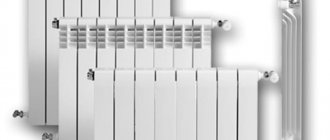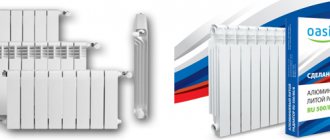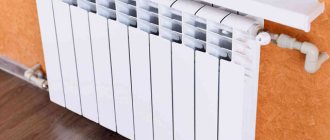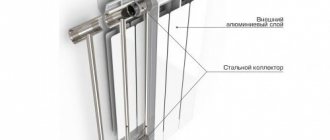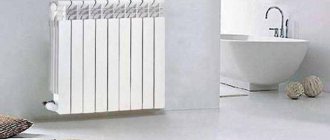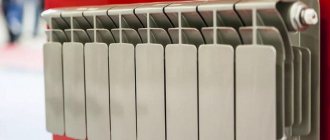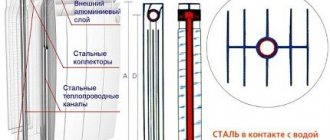The most important characteristic of a radiator is heat transfer (heat flow). The nominal heat flow is determined under standardized conditions: the difference between the average temperatures of the coolant in the radiator and the air in the heated room is 70 degrees C, the coolant flow through the radiator is 0.1 l/s at an atmospheric pressure of 760 mm Hg, the coolant is supplied from above down from different sides of the radiator. The heat transfer of one section of the RIFAR-B 500 radiator under normal conditions is 204 W.
The installation kit is purchased separately.
Model description
Design of the Rifar 500 radiator
The radiator section is a single steel pipe, which is filled with aluminum alloy using a special technology under very high pressure. Using a high-quality silicone gasket of an original design, the sections are connected to one another and a monolithic product is obtained that has high strength and good heat transfer.
Purpose
This model is the most powerful among bimetallic radiators and is intended for large rooms with poor insulation. The high heat transfer of the radiator guarantees heating and maintaining a comfortable temperature for production facilities or living rooms in a house or apartment.
Advantages
- Bimetallic radiators of the Rifar model line have low thermal inertia and are able to quickly change heat transfer parameters, that is, they quickly heat up and cool down. This allows them to be used in systems with autothermoregulation, which is their undoubted advantage.
- Rifar radiators can be used both in houses with centralized heating, and in houses or other objects with an autonomous heating system.
- They have a high safety margin, as they undergo pressure testing under high pressure of 30 atmospheres, which ensures safety when used in emergency situations.
- Radiators have a long “life” resource and protection against corrosion, thanks to a special coating of the internal and external surfaces.
- Rifar models provide excellent heat transfer and the highest possible temperature conditions up to 135 degrees.
- They have a beautiful design and can be painted in any color at the buyer’s request.
- Radiators can be configured with a different number of sections.
- The core is manufactured using a special technology from special steel, as a result of which it is able to withstand very heavy loads and has low heat transfer, while aluminum fins have high heat transfer.
- With excellent quality and stylish design, they have an attractive price.
Customer ratings
Another quite important conclusion! In terms of quality and price, Rifar products are the most attractive. Manufacturer's Warranty
Manufacturer's Warranty
All brand products are certified by SANROS and comply with Russian safety standards for products of this class. The manufacturer has insured its product against all possible risks.
Bimetal and semi-bimetal: what is the difference?
Conventional bimetallic radiators have a casing made of aluminum. The rest of its parts are made of other metals. During the manufacturing process, steel cores are placed into special molds and then filled with molten aluminum. After solidification, this metal does not come into contact with the coolant in any way, and serves solely as a heat exchanger. Such batteries are best suited for installation as part of any heating systems.
If we talk about semi-bimetallic radiators, then in their design the steel pipe is present only in the vertical part of the radiator. The horizontal passages remain aluminum. It is possible to install such batteries as part of a central heating system, but since the coolant in such systems can rarely boast of purity and the absence of alkaline impurities, such radiators may last less than completely bimetallic ones.
Comparison of bimetallic and aluminum radiators
The power of the aluminum and bimetallic radiator sections is identical. which gives them the same performance, but there are some differences in characteristics
What you should pay attention to when choosing batteries
- Reliability - for an autonomous heating system in which there is no threat of water hammer, aluminum equipment will be sufficient, but if it is intended to be used in a centralized heating system, it is better to play it safe and choose bimetal as it is more resistant. It is guaranteed to withstand even a serious jump and will not leak.
- Cost is one of the most important criteria, which often outweighs any arguments. The cost of aluminum radiators is on average two times lower than the cost of bimetallic radiators, with equal characteristics. If we compare the price-quality ratio, aluminum wins, but subject to control of the pressure in the system.
Both bimetallic and aluminum radiators will meet their characteristics only if they are produced using modern equipment and according to technology. You should not try to save money and purchase a surprisingly cheap model from a little-known manufacturer. Probably its quality, regardless of the material, leaves much to be desired.
Rating: 0 Votes: 0
To ensure optimal performance of the heating system, the number of radiator sections per heated area is calculated. Quite often it turns out that a standard radiator is not enough and sections need to be added, otherwise the heating will not be effective. Let's look at how to use soy correctly.
To get the most efficient heating system with high efficiency and minimal energy consumption, it is necessary not only to select the most suitable radiators, but also to perform the correct installation. Given the increased popularity of bimetallic batteries, let's take a closer look at their connection. P.
In this article we will look at what is better: a radiator or a convector for a reliable and economical option for heating both your apartment and a private home; we will list several reliable and trusted manufacturers that you can trust to heat your home. The question of reliable heating faces many people.
A thermal valve for a heating radiator is a very necessary addition, without which your heating system will not work fully. More precisely, it will work, but it will be impossible for you to regulate the temperature of the system and, accordingly, the temperature in the room. In order to.
Comparison with other models on the market
As a rule, radiators are selected based on their ability to withstand system pressure and heat transfer. Sira and Global
heating devices The Italian company Global has been producing radiators for over 30 years. All models are designed to meet the conditions of Russian reality, have a reinforced design and can be installed in our heating systems. The company's developers focused on quality, durability, reliability and design. Global radiators undergo two-stage painting, as in the automotive industry. They have stable anti-corrosion properties and high heat transfer.
The Italian company Sira is a long-time partner of the holding company SanTehKomplekt. Aluminum and bimetallic radiators supplied by this company to our country are suitable for use in any heating system. They come from the manufacturer in paired sections, the edges of the radiators are rounded to avoid injuries in families with children. The technical parameters of the radiators comply with the requirements of SNiP for the operation of devices in urban heating systems, for example, Gladiator batteries operate perfectly at an operating pressure of 35 atm, they have a shallow depth, which saves space, high anti-corrosion parameters, and there is no noise during the passage of coolant. Sira radiators can be easily installed; all necessary installation elements are included in the package.
Delivery
Delivery within the city: from 350 rub. , November 28
Delivery to the regions: from Moscow
Gross weight of goods: 26.39
kg
Dimensions in packaging, mm: 960
x
110
x
600
In which city do you want to receive the goods?
select cityAbakanAdlerAksaiAktauAktobeAlexandrovAlmatyAlmetyevskAnadyrAnapaAngarskArmavirArtemArkhangelskAstanaAstrakhanAtyrauAkhtubinskAchinskBaiserkeBakuBalakovoBalashovBalezinoBalkhashBaranovichiBarnaulBatayskBelgorodBelogorskBelokurikhaBeloyarskyBerezniki BiyskBirobidzhanBlagoveshchenskBobruiskBodayboBorBorisoglebskBratskBrestBryanskBugulmaBuguruslanBudenovskBuzulukVeliky NovgorodVitebskVladivostokVladikavkazVladimirVolgogradVolgodonskVolzhskVolzhskyVologdaVolskVorkutaVoronezhVoskresenskVyborgVyksaVyshny VolochekV YazmaVyatskie PolyanyGlazovGomelGorno-AltaiskGrodnoGroznyMudGubkinGubkinskyDalnegorskDerbentDzerzhinskDimitrovgradDonetskFriendlyDudinkaEvpatoriaEgoryevskEkaterinburgEletsEssentukiZhezkazganZheleznodorozhnyZabaikalskZelenodolskZlatoustZubovoIvanovoIgnatovo ZhevskIntaIrkutskIshimYoshkar-OlaKazanKaliningradKalugaKamensk-UralskyKamensk-ShakhtinskyKamen-on-ObiKanashKanskKaragandaKarasukKemerovoKerchKizlyarKineshmaKirovKiselevskKlinKlintsyKogalymKokshetauKolomnaKolpashevoKomsomolsk-on-AKomsomolsk-on-AmurKostanay KostromaKotlasKrasnovisherskKrasnodarKrasnoyarskKropotkinKuznetskKuibyshevKumertauKurganKurskKyzylKyzylordaLabinskLabytnangiLagovskoyeLangepasLeninsk-KuznetskyLesosibirskLidaLipetskLiskiLyubertsyLudinovoMagadanMagasMagnitogorskMaykopMalye KabanyMakhachkala MezhdurechenskMiassMinskMirnyMikhailovkaMichurinskMogilevMoscowMuravlenkoMurmanskMuromNaberberezhnye ChelnyNadymNazranNalchikNaro-FominskNaryan-MarNakhodkaNevinnomysskNeryungriNeftekamskNizhnevartovskNizhnekamskNizhny NovgorodNizhny TagilNovaya CharaNovozybkovNovokuz NetskNovorossiyskNovosibirskNovosibirsk SouthNovocheboksarskNovocherkasskNovy UrengoyNoginskNorilskNoyabrskNurlatNyaganObninskOdintsovoOzerskOktyabrskyOmskOrelburgOrskPavlovoPavlodarPangodyPenzaPermPetrozavodskPetropavlovskPetropavlovsk-KaPetropavlovsk -KamchatskyPodolskPolotskPolyarnyPrigorodnoyeProkopyevskPskovPyatigorskRossoshRostov-on-DonRubtsovskRybinskRyazanSalavatSalekhardSamaraSt.PetersburgSaranskSarapulSaratovSevastopolSeverobaikalskSeverodvinskSeverskSemeySerpukhovSimferopolSlavyansk- na-KubanSmolenskSovietSoligorskSolikamskSorochinskSochiStavropolStary OskolSterlitamakSurgutSyzranSyktyvkarTaganrogTairovTaximoTaldykorganTambovTarazTashtagolTbilisiTverTikhoretskTobolskTogliattiTomskTuapseTulaTyumenUlan-UdeUlyanov SKURAIUralskUsinskUsolye-SibirskoyeUssuriyskUst-IlimskUst-KamenogorskUst-KutUst-LabinskUfaUkhtaFeodosiaKhabarovskKhanty-MansiyskKhasavyurtKhimkiTchaikovskyChelyabinskCheremkhovoCherepovetsCherkesskChitaChusovoySharyaShakhtyShymkentSchelkovo EkibastuzElektrostalElistaEngelsYugorskYuzhno-SakhalinskYakutskYaltaYalutorovskYamburgYaroslavl
Flex
The uniqueness of bimetallic radiators of this series lies in the possibility of imparting a certain curvature to the plane. This model is equipped with base series sections, but thanks to the bracket system it is possible to produce both convex and concave radiators.
The minimum bending radius is 1450 mm. To order radiators of this shape, you must specify the bending radius and direction. It is noteworthy that all technical parameters are preserved regardless of the form.
How to calculate radiator power
Dependence on the number of pipes
No matter how high-quality the batteries are, they will not be able to provide the necessary heat transfer if the initial calculation of the power and number of sections was carried out incorrectly. The basis of calculations is the power of one section. It is indicated by the manufacturer in the specifications for the product. But it is necessary to take into account that average indicators may differ significantly from real ones.
To calculate heat transfer, the parameter ∆t is used, which is the difference between the air temperature in the heated room and the temperature in the system. In practice, this figure rarely exceeds ∆t 50°C. At the same time, it is declared by manufacturers as ∆t 70 °C, which represents ideal conditions.
When calculating, it is necessary to take into account other data:
- The location of the room in the house.
- Condition of building structures.
- Sizes and location of windows and doors.
- The materials from which the house is built.
- Type of boiler equipment used, etc.
The simplest calculation can be made using the formula - the area of the room multiplied by 100 and divided by the power of one section. For example, to effectively heat a room of 25 square meters. m requires 16 sections. This figure is obtained from a simple calculation - 25 × 100/150.
Base
Its device is based on the special design of the parts of the connected sections and the parameters of the silicone gasket.
RIFAR Base radiators are presented in three models with center distances of 500, 350 and 200 mm.
The RIFAR Base 500 model with a center distance of 500 mm is one of the most powerful among bimetallic radiators, which makes it a priority when choosing radiators for heating large and poorly insulated rooms. The RIFAR radiator section consists of a steel pipe filled under high pressure with an aluminum alloy having high strength and excellent casting properties. The resulting monolithic product with thin fins provides effective heat transfer with a maximum safety margin.
The availability of RIFAR Base 350 and RIFAR Base 200 models with center distances of 350 and 200 mm allows you to maintain a single style in rooms with different height restrictions in the places where they are installed. A special feature of RIFAR Base 200 is the closed rear surface of the section, which allows the device to be used in combination with French windows.
Produced in series from 4 to 14 sections, color according to RAL 9016 catalogue.
For the Base 500/350/200 models, only specially prepared water can be used as a coolant, in accordance with clause 4.8. SO 153 – 34.20.501 – 2003 “Rules for the technical operation of power plants and networks of the Russian Federation.”
Confirming the high design characteristics of its radiators and strict quality control, it provides a guarantee for its products for a period of 10 years and at the same time guarantees its uninterrupted operation for 25 years from the date of installation, subject to the rules of transportation, installation and operation. All products manufactured are certified according to GOST 31311-2005 and insured by INGOSSTRAKH IJSC.
Information on providing a guarantee can be found in the passport.
Technical characteristics of one section
| Межосевое SЂР°СЃСЃС‚РѕСЏРЅРёРµ (РјРј) | Габаритные размеры (РјРј) | RќРѕРјРёРЅР°Р»СЊРЅС‹Р№ тепловой поток (Р'С‚) | Объем S‚еплоносителя (Р”) | Масса (РєРі) | ||
| высота | глубРеРЅР° | ширина | ||||
| 200 | 261 | 100 | 80 | 100 | 0,16 | 0,9 |
| 350 | 415 | 90 | 80 | 139 | 0,18 | 1,25 |
| 500 | 570 | 100 | 80 | 197 | 0,20 | 1,84 |
- Passport:
Base radiator passport (.pdf) 4.8 MB - Certificate:
What is bimetal
Bimetal is a relatively new type of heating battery material that consists of two metals, a steel core inside and an aluminum casing on top. This combination is designed primarily to work with high pressure in radiators, up to 40 atmospheres.
Without understanding what bimetallic heating radiators are and how they function, it is impossible to think through the heating system of a home. Even if you prefer more economical options, do not rush to abandon bimetal products - after all, they have very high performance characteristics.
When developing such batteries, the designers set out to produce a product that would have the high heat transfer properties of aluminum, but would not have the disadvantage of poor corrosion resistance. The result is a heatsink that incorporates a less demanding steel core within an aluminum shell.
This product perfectly heats the room - the section power is up to 190 W, but lasts an order of magnitude longer than its aluminum “brother”.
Bimetallic heating devices today are the best choice for a city apartment. Elegant and powerful, like aluminum, they perfectly withstand high pressure, water hammer and resist corrosion. Such devices have been successfully used for a long time in open urban heating systems in many Russian cities.
The collectors and vertical channels of such radiators are made of steel tubes, and the outside is filled with aluminum alloy under pressure. Steel holds pressure well, and aluminum transfers heat well to the air.
- It has many other advantages:
- tolerate water hammer well during seasonal startup work;
- ease and simplicity of installation;
- their laconic and elegant appearance makes them suitable for any interior;
- can withstand pressure up to 35 atmospheres;
- can last up to 20 years.
As mentioned, the main disadvantage of such products is their high price. In addition, although steel is more resistant to corrosion than aluminum, it still suffers from it. Especially if air bubbles get into the system. If the coolant is of very low quality and contains small particles, the bimetal will also not be a panacea for rapid wear.
Power of one section of aluminum radiator
Such batteries are characterized by 2 types of construction: cast and extruded. The first is made in the form of separate sections, and the second is in the form of 3 parts glued or bolted together. In addition, the aluminum itself used for manufacturing may be primary, i.e. pure raw materials, or secondary ones, which are produced from scrap or dirty alloys. The price of the latter is much lower. When choosing any model, its performance characteristics are important, which include:
- Working pressure is the amount of water exposure that a heating device can withstand while maintaining its original condition. Modern devices have this indicator from 6 to 16 atmospheres. Devices with low operating pressure are used in private houses or apartments, country houses and cottages, where the coolant is controlled by the user. Municipal heating systems require more reliable products that can withstand pressure surges.
- Heat dissipation. Heating devices made of aluminum have an advantage over cast iron, because they have high thermal conductivity, which leads to the release of the maximum amount of energy into the room. Heat transfer depends on the power of one section of the aluminum radiator and varies from 140 to 200 Watts.
Popular series of bimetallic batteries Rifar
The most popular series of Rifar bimetallic batteries is Monolith.
This heating system is innovative in technical terms, and heat transfer, tightness and reliability are at the highest level. The Rifar Monolith series with a coolant having a temperature of 135 degrees and high pressure can operate flawlessly for 25 years. In this case, various types of coolant are used, for example, antifreeze or plain water.
Radiators of the Monolith series perfectly warm up even a large area of the room, without the use of additional heating equipment.
Method of connecting sections
In bimetallic heating radiators, the sections are connected to each other using steel threaded nipples. In the manufacture of Monolit series radiators from the Rifar company, another type of connection is used - welding. This model of heating devices can withstand increased pressure (operating up to 100 atm) and temperature (up to 135°C versus 110°C for nipple models).
Diagram of a monolithic radiator.
Bimetallic radiators are the most technically advanced heating device for water heating systems. Combining high efficiency and good performance indicators, devices of this type are optimal for use in domestic conditions. Knowing the technical characteristics of bimetallic heating radiators of various models, you can choose a heating device that best suits the operating conditions in a particular room.
Advantages and disadvantages
According to reviews from customers who use Rifar bimetallic heating batteries, the devices really have all the advantages, features and good quality.
Among the positive characteristics of radiators it is necessary to highlight:
- versatility, since the battery can be installed in both an apartment building and a private house;
- possibility of installation in private and centralized heating systems;
- The maximum temperature of the thermal agent is 135 degrees.
- high thermal power, thanks to which the room heats up in the shortest possible period of time;
- if necessary, it is possible to independently regulate the heating;
- low price compared to foreign analogues.
Rifar radiators not only have positive operational features, but also have some disadvantages:
- The equipment is not entirely made of bimetal. And completely bimetallic products have even greater heat transfer and high strength.
- Unreliable thread, but you can solve this problem yourself.
Advantages of Rifar radiators
Rifar radiators are universally suitable for private and apartment buildings.
The obvious advantages of the Rifar b 500 radiator include versatility. It is installed in apartment buildings where centralized heating is used, and in private houses. However, in the latter case, you should not use an autonomous system. It would be much better to connect the radiator to a centralized heating system.
Temperature regulation is another plus, but for connection you will need to purchase a separate thermal head, thermal valve, radius thermostat, and thermal valve. For installation – 4 adapters, air vent valve, plug.
Considering the small internal volume of 1 section of the Rifar bimetal 500 0.136 kW radiator, low inertia is easily achieved. The small volume allows you to quickly heat the room and quickly cool it. This is appropriate if you need a higher temperature during the day and a lower temperature at night.
The polyurethane bushing is a part that connects the sections to each other, thanks to which tightness is achieved. In addition, laser welding of heating equipment contributes to tightness.
The solidity of the radiator allows installation without special adapters.
Beautiful design is also an advantage; the manufacturer allows the device to be painted in any desired color.
Radiators RifarBase and Alp
The Base series is the simplest and most convenient for installation in apartment buildings with a standard connection type. Each section has specified parameters for height, width and depth, on which the overall heat transfer depends. The main advantage of the model is the ability to supplement the heating system with the required number of sections, taking into account climatic conditions, room size and layout features. Variations in center distances from 200 to 500 mm and different section heights allow you to install Base series radiators in any type of window opening. The weight of one section does not exceed 2 kg, so installation and installation are quick and easy.
The Alp series is an improved model of the basic series of Rifar sectional radiators. A distinctive feature is its shallow depth, which is important when installing a heating radiator under narrow window sills without a niche. The internal structure of each section is similar to the previous line, but the outer part of the housing differs in the arrangement of aluminum surfaces for maximum heat transfer at a shallow depth. The center distance is standard for the Alp line and is 500 mm. Due to its shallow depth, each section weighs less than 1.5 kg, which makes installation easier and expands the possibilities for choosing the type of radiator mounting.
Both series of Rifar sectional radiators work with the same type of coolant, which can be used as technical water with parameters specified in accordance with GOST. The manufacturer's warranty is 10 years, while compliance with operating conditions increases the warranty period for uninterrupted service of the device to 25 years.
Technical characteristics of Rifar Base radiators
| Model name | Center distance, cm | Height, cm | Depth, cm | Width, cm | Weight of one section, kg | Heat transfer of one section, W |
| Rifar Base 500 | 50,0 | 57,0 | 10,0 | 7,9 | 1,92 | 204 |
| Rifar Base 350 | 35,0 | 41,5 | 9,0 | 7,9 | 1,36 | 136 |
| Rifar Base 200 | 20,0 | 26,1 | 10,0 | 7,9 | 1,02 | 104 |
Average price of Rifar Base 500 radiators
| Radiator model name | External dimensions, cm | Power, W | Number of sections | Price |
| Rifar Base 500/1 | 57,0/10,0/7,9 | Up to 204 | 1 section | from 450 rub. |
| Rifar Base 500/4 | 57,0/10,0/31,6 | Up to 816 | 4 sections | from 1820 rub. |
| Rifar Base 500/5 | 57,0/10,0/39,5 | Up to 1020 | 5 sections | from 2280 rub. |
| Rifar Base 500/6 | 57,0/10,0/47,4 | Up to 1224 | 6 sections | from 2742 rub. |
| Rifar Base 500/7 | 57,0/10,0/55,3 | Until 1428 | 7 sections | from 3200 rub. |
| Rifar Base 500/8 | 57,0/10,0/63,2 | Before 1632 | 8 sections | from 3650 rub. |
| Rifar Base 500/9 | 57,0/10,0/71,1 | Before 1836 | 9 sections | from 4100 rub. |
| Rifar Base 500/10 | 57,0/10,0/79,0 | Until 2040 | 10 sections | from 4570 rub. |
| Rifar Base 500/11 | 57,0/10,0/86,9 | Up to 2244 | 11 sections | from 5027 rub. |
| Rifar Base 500/12 | 57,0/10,0/94,8 | Up to 2448 | 12 sections | from 5484 rub. |
Tips for choosing
When choosing heating batteries, it is necessary to take into account technical features and operating conditions. The technical features of heating batteries allow them to be installed in systems with forced operation of a thermal agent. Rifar models have high thermal output and long service life. Installed in high-rise buildings.
When choosing bimetallic radiators, you need to focus on their positive qualities:
- Tightness thanks to a polyurethane sleeve, which acts as a connecting element of the sections.
- High thermal performance - one section has a power of 0.104, 0.136, 0.204 kW. The maximum height of one section is 57 cm. Batteries are available in 4, 6, 8, 10 and 12 sections. The heated area of the room is 25 m2.
Monolithic bimetallic batteries are considered the most reliable heating systems, which are recommended for installation in educational, medical and administrative institutions.
High heat transfer is created due to the optimal ratio of heat from the radiation and convection chambers. However, the heat transfer of such models is slightly less than that of conventional bimetallic batteries.
The main advantages of monolithic bimetallic radiators:
- The diameter of the pipe allows installation without adapters;
- tightness, which is ensured by laser welding of heating equipment.
However, monolithic bimetallic batteries cannot be connected to an autonomous heating system for cottages. The recommended optimal connection is to centralized heating systems.
An equally important point when choosing a bimetallic battery is its connection option. Rifar radiators come with side and bottom connections, each option has some advantages.
Radiators with side connections – “Ventil”. The connection is made by a special node, which is located at the bottom of the circuit. It often happens that after installation and connection, uneven heating of the sections occurs. To optimize heating, it is necessary to install a flow extender, which will ensure intensive circulation of the coolant. The connection is made according to the top-down scheme. Thus, the thermal agent will be supplied from above, and removed through the lower channel. Also, if there are a large number of sections, a flow extender may be needed.
Radiators with bottom connections ensure stable operation of the heating system without installing additional elements. However, to compress the air from the device, it is necessary to connect the Mayevsky valve and the thermostatic head.
In the passport of each device, the manufacturer indicates recommendations for installation and operation of the product:
- Water as a coolant with a hydrogen index of 7 - 8.5. When using another thermal agent, there is no guarantee of the radiator's performance.
- To avoid premature corrosion, it is necessary to take care of grounding and grounding when using metal pipes or liners made of dielectric materials.
- The radiator must be installed by a specialized installation company.
- Before installation, the radiator must reach room temperature.
- Do not install in rooms with high humidity levels (more than 75%).
Only if you follow these recommendations you won’t have to worry about the lifespan of your heating radiator.
In the next video you will find a video presentation of the production of Rifar heating radiators.
Capacity of the bimetallic radiator section
The main characteristics of bimetallic radiators include section capacity . This parameter directly depends on the center distance. For the most common 500 mm models, the section capacity is 0.3 liters of coolant .
In bimetallic heating radiators, the coolant circulates through steel cores - H-shaped welded structures, which consist of a lower and upper collector connected to each other by a heat conductor (vertical tube). Each manifold has two internally threaded side holes for connecting the sections using steel nipples. With this design, the coolant does not come into contact with aluminum parts, which increases the service life of the radiator. The steel cores of bimetallic devices use only round tubes, so the capacity of the sections of such devices is less than that of aluminum ones, in which the heat conductor has an oval cross-section.
Note that a round steel insert mounted inside a bimetallic radiator ensures long-term heat retention . Due to the relatively small volume of the section, thermal inertia is reduced, resulting in reduced costs for maintaining heat.
Calculation of heating batteries per room
The number of products can be determined only after calculating the required number of sectional elements. Next, you need to decide how many devices you will install. In our example, it turned out that one should have 10 sectional parts. This can be a whole product installed under the window. For a corner room, it is better to divide this number in half or into 4 and 6 parts and mount a device at each outer wall. Another option is to calculate the heat value required to heat the room:
- For our example, it is – 100*16 = 1600 W or 1.6 kW.
- Next, select a specific product and determine its heat transfer by multiplying the characteristic of one element with the same name by their number. For example, let's take a 6-section model with an indicator of 180 W for one part - 6 * 180 = 1080 W.
- Divide the required heat value by the power of the entire device - 1600/1080 = 1.48. We round this value up. As a result of the calculations, we obtain a quantity equal to 2.
Types of aluminum batteries
Note! Aluminum radiators are produced by two methods - casting and extrusion. When using the casting method, each section is manufactured separately
The raw material is silumin - aluminum with silicon additives not exceeding 12%. Casting produces sections of various shapes that can withstand pressures of up to 16 atmospheres.
The extrusion method does not produce radiators, but their individual parts, which are then fastened together. This method makes it possible to reduce the cost of production, but in terms of technical characteristics, batteries created by extrusion are inferior to cast ones. They also have one more drawback - it is impossible to change the number of sections in the radiator.
It is impossible not to note another type of aluminum batteries - anodized type. They are the most expensive and, of course, high quality. The raw material for their production is purified aluminum. The finished product is anodized, making it completely corrosion-resistant. The individual parts in such radiators are connected by couplings.
Therefore, they are absolutely smooth inside, which means they are not afraid of scale accumulation. Their working pressure is up to 70 atmospheres.
Construction of bimetallic heating devices
A bimetallic heating device is indistinguishable in appearance from one made of aluminum. Their main difference is that inside the bimetallic heating device there is a steel body welded from stainless steel, and an aluminum body is installed on top of it.
Construction of bimetallic heating devices
This design ensures that the device will not have contact with the coolant. In addition, steel is much more resistant to the effects of various aggressive substances present in large volumes in centralized thermal energy supply systems. By the way, in some networks, washing is carried out with the addition of a 5% solution of orthophosphoric acid.
The use of steel elements increases the operating life of heating devices. According to some manufacturers, the service life of such structures is up to twenty years.
Service life of heating radiators.
The presence of steel inside the bimetallic heating radiator provides significant structural strength. A device of this type can withstand operating pressures of up to 40 atm. Thus, the bimetallic product can withstand serious hydraulic shock.
Narrowed channels guarantee the most effective combination of the thermal inertia of the radiator and the flow rate of the amount of coolant required to heat a given volume.
If we take into account all the properties listed above and add to them high thermal efficiency and a stylish appearance, we can safely say that today bimetallic heating devices are optimal for installation in modern apartment buildings.
Original design of bimetallic batteries
Types of Rifar heating radiators
Rifar's product range is quite diverse.
The company produces monolithic and sectional radiators. There are products with a radius of curvature that are designed for rooms with convex or concave walls. Batteries are most often painted white, but any shade can be selected at the client’s request. Depending on the material from which Rifar radiators are made, they are divided into the following types:
- aluminum. Rifar products are made from very high quality and durable aluminum, which can withstand pressure surges and large temperature changes. Such batteries have a very attractive appearance, and the large range of Rifar products allows you to choose the model you like for any room.
- bimetallic. Such batteries are considered reliable due to the combination of several materials at once, and the level of heat transfer from the heating source to the air increases significantly.


